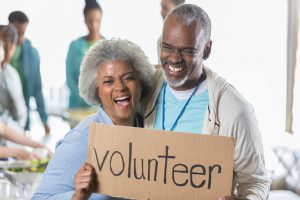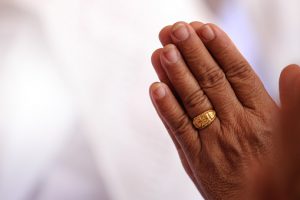Your Participation Matters
Is there a connection between volunteering and well-being for older adults?

Data from the US Bureau of Labor Statistics shows that about one quarter of Americans take the time to volunteer in their communities. One might traditionally view volunteering as a way to help out our communities and make a difference in the lives of others. However, there are important health benefits for individuals who volunteer. In a research study that uses data from ACL, researchers reported that in adults over the age of 60 years, volunteering has a positive effect on well-being. Furthermore, this relationship between volunteering and well-being is universal for both men and women. So, volunteering is a win-win situation: we can help our communities while also contributing to our own well-being!
Can religious service affect our health?

Attending religious services may be a part of your weekly routine. Now, there is research to support that regularly attending religious services can improve health and increase life expectancy.
In a research study using data from ACL, researchers found that those who attended religious services, compared to those who didn’t, had a longer life expectancy. This was partly facilitated by the lifestyle, physical activity and social relationships of those who attended religious services.
Services often include activities like singing, dancing and taking communion. When people engage in these activities among other people doing the same, feelings of self-identity and well-being are reinforced.
Engaging with people, whether by attending a religious service or being involved in other community events, has a great impact on our own well-being and that of those around us. People who interact with their communities benefit from their engagement. Take a moment to check out what community events are happening near you!
Do our social connections affect our health?
 Social networks include people like our children, siblings, spouses, neighbors and even current and former co-workers. Researchers have shown that the number and types of social networks that older adults have can affect their quality of life. Using data from ACL, researchers examined how the types of social networks people have can influence mental health.
Social networks include people like our children, siblings, spouses, neighbors and even current and former co-workers. Researchers have shown that the number and types of social networks that older adults have can affect their quality of life. Using data from ACL, researchers examined how the types of social networks people have can influence mental health.
The researchers found several types of social networks that older adults have, with the most common being:
- A diverse network is characterized by having frequent contact with spouses, children, friends, and neighbors, as well as frequent attendance at religious services and involvement with community organizations. This type of network was most common among ACL participants.
- A non-family restricted network has the least social interaction of all network types. People with these types of networks were the least likely to have spouses or children, and had limited contact with family, friends, or other community members.
- A non-friends restricted network is also characterized by limited social interaction. Though they were likely to include spouses and children, people with this network type had limited contact with family, friends, neighbors or other community members, and did not attend religious services or community organizations frequently.
The researchers found that of all the networks types, those in the diverse network category had the fewest symptoms related to depression, while those in the non-family restricted network had the most. This research suggests that many sources of social support seems to be best for our morale and mental health.
Can our neighborhood environment impact our health?

Go outside on a warm summer’s day and around you, you might find sidewalks, housing, streetlights and parks. All of these are parts of “the built environment.” The built environment includes human-made structures that we come into contact with everyday. The built environment impacts everything from the way we get around town, to the quality of the air we breathe.
Moreover, the built environment plays an important role in mobility in older adults. Using information drawn from ACL, researchers found that older adults who lived in communities that were not pedestrian-friendly were more likely to report mobility disabilities, such as having trouble walking either inside or outside of the home. This study suggests that our built environments may affect our healthy aging and that it should be a priority when trying to improve the health of aging communities.
Beyond Obamacare: The importance of social and economic policies for health

In 2015 or 2016, you received a copy of “Beyond Obamacare” by James House, the former director of the Americans’ Changing Lives study. We hope you have had a chance to read, or skim, this book as it contains very interesting and timely information about the state of health and healthcare in America. If you haven’t had a chance to glance through the book, there’s no time like the present!
America is an outlier of the wealthiest countries because we spend the most on healthcare, but have the poorest overall health. In Beyond Obamacare, House offers that in order to address America’s health crisis, there should be a shift from solely investing in policies that increase access to healthcare, to investing in policies focused on the social determinants of health.The social determinants of health are the conditions in which we live, work and play. Examples include the jobs we have, the quality of education our children receive, and the safety of our neighborhoods. This preventative approach to health, House explains, prevents Americans from needing to rely so heavily on the healthcare system once illnesses arise.
As a nonpartisan approach to addressing poor health outcomes in America, Beyond Obamacare is a must read!
How can the ACL study help us understand health disparities by race, gender, educational level, and other identities?
Attaining healthy, thriving lives and well-being free of preventable disease, disability, injury, and premature death, and eliminating health disparities to achieve health equity are cornerstone goals of the Healthy People 2030 program, led by the U.S. Department of Health and Human Services.
The Americans’ Changing Lives is one of the few surveys in the U.S. that allows researchers to study the health and well-being of Americans through their lives and as they get older. Because we collect data mainly from Black and White Americans from across the nation, ACL researchers can help to explore the reasons for persistent disparities in health by race, gender, educational level, and other identities.


